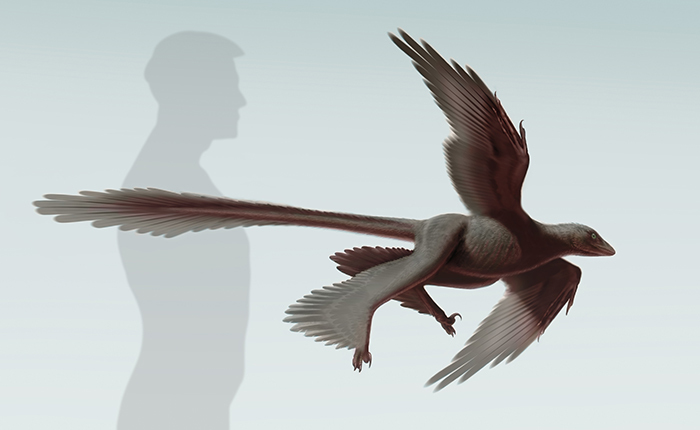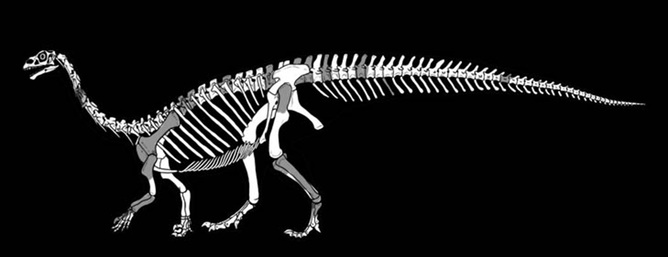Unravelling the mystery of how dinosaurs get their names
08 July 2015 | Story by Newsroom
Many kids can recite an A-Z list of dinosaur names. They take special delight in defeating tongue-twisters like Carcharodontosaurus, Ekrixinatosaurus, Huehuecanauhtlus and Zuchengtyrannus.
Sir Richard Owen came up with the name dinosaur in 1841 to describe the fossils of extinct reptiles. He coined the word by combining the Greek words "deinos", which means terrible, and "sauros", which means lizard.
What lies behind a name
A dinosaur's name says something about the dinosaur itself. Scientists often use Greek or Latin root words to give a name that describes the dinosaur in some way.
Dinosaurs, like all living organisms, are classified or grouped together according to similarities they share, which also indicates their ancestral relationships to one another. To do this objectively, scientists apply cladistics, a methodology that enables the assessment of relationships of organisms to one another based on shared characteristics.
According to the classification system, there are always two parts to a dinosaur's name – or any living organism for that matter – and they should both be italicised. The first part of the name is called the genus name and the second the species name.
There can be several different species (varieties) of a particular genus of an animal. For example, humans are Homo sapiens, but in the fossil record there are several other members of the genus Homo for example Homo neanderthalensis, and Homo erectus.
Before it can become official, and to prevent duplication, once palaeontologists have chosen a new name it has to be approved by the International Commission on Zoological Nomenclature. Palaeontologists must also fully describe the anatomy of the dinosaur and explain the cladistic analyses and the derivation of the name in a peer-reviewed academic journal.
Who gets to have a dinosaur named after them
Only a few palaeontologists ever have the opportunity of naming a dinosaur, and even fewer have species named after them. Paleontologists get to name a dinosaur if they, or an expedition team, finds an animal that is distinct from any others known.
Occasionally the remains of a dinosaur may have been excavated a long time ago, but subsequent investigations reveal that it is in fact a new dinosaur. This is the case of Sefapanosaurus zastronensis, South Africa's most recently named dinosaur which was excavated more than 80 years ago close to Zastron, a small town near South Africa's border with Lesotho. At the time it was collected it was unnamed. Later scientists studied the bones cursorily and considered them to be like that of another early dinosaur called Aardonyx.
But the material was recently re-examined and found to be quite unlike any of the known contemporary dinosaurs.

Sefapanosaurus as compared to a soccer player to give an idea of its size. Shaded bones in the Sefapanosaurus skeleton show the fossilised remains in the collections.
Given that its ankle bone had a very unusual cross shape we decided to name the dinosaur after this feature and to give it a Sesotho name, since this is the language prevalent in the area. Thus Sefapanosaurus is derived from "sefapano" which means "cross" in Sesotho and "saurus" which is Greek for "lizard". The second part is derived from Zastron.
Like Sefapnosaurus, many dinosaurs are named for particular features in their skeletons. For example, last year, I was fortunate to be part of the team that named a rare four-winged, long-tailed dinosaur from northeastern China, Changuraptor. "Changu" means "long feather" in Chinese, and "raptor" refers to its predatory habits. The second part of the name honours Yang Yandong, chairman of Bohai University, who provided funding to obtain the specimen.
There is a curious story about a Southern African predatory dinosaur called Syntarsus. Thirty-two years after it was named entomologist realised that the name was already given to a beetle in 1869 and they renamed the dinosaur, much to our dismay, Megapnosaurus, which means "big dead lizard".
Another South African dinosaur, which we named in 2010, is Aardonyx celestae. This dinosaur's name has its roots in Afrikaans ("aard" means earth) and Greek ("onyx" means claw), and refers to the fact that the animal had thick iron rich sediments, or hematite, surrounding many of its foot bones. The second part of the Aardonyx name pays tribute to Celeste Yates, who as a volunteer did the laborious, painstaking preparation of the fossils by removing the surrounding rock matrix in which they were embedded.
Ten years ago I was also part of the team that named Nqwebasaurus thwazi, the first isi-Xhosa-named dinosaur. This dinosaur was discovered from the Kirkwood cliffs near Grahamstown in the Eastern Cape by my colleagues, Billy De Klerk from the Albany Museum and Callum Ross from the US. In isi-Xhosa, the Kirkwood region is known as "Nqweba". "Thwazi" means fast-runner.
I have also had the privilege of being on the team that named Zhouornis hani, a large Mesozoic bird from China. In this case, the early bird is named after Zhou Zhonghe, a Chinese palaeontologist who has made a huge contribution to studies about the early evolution of birds. The species name honours the collector of the specimen, Lizhuo Han.
All dinosaur names have a particular meaning. It is fascinating to understand the derivation of their names, and to learn of the sometimes quirky stories behind them.
Written by Anusuya Chinsamy-Turan, Professor, Head, Biological Sciences Department at University of Cape Town
Disclosure statement: Anusuya Chinsamy-Turan receives funding from the National Research Foundation.
|
This article first appeared in The Conversation, a collaboration between editors and academics to provide informed news analysis and commentary. Its content is free to read and republish under Creative Commons; media who would like to republish this article should do so directly from its appearance on The Conversation, using the button in the right-hand column of the webpage. UCT academics who would like to write for The Conversation should register with them; you are also welcome to find out more from carolyn.newton@uct.ac.za. |
![]()
 This work is licensed under a Creative Commons Attribution-NoDerivatives 4.0 International License.
This work is licensed under a Creative Commons Attribution-NoDerivatives 4.0 International License.
Please view the republishing articles page for more information.










